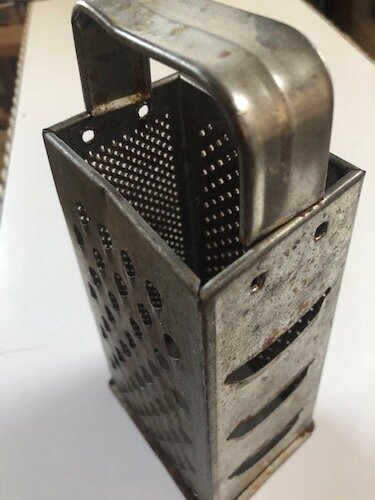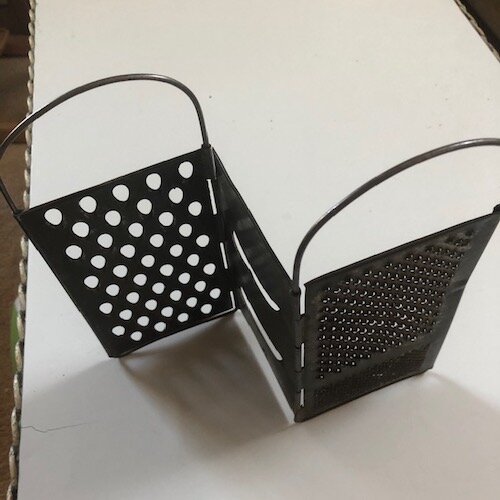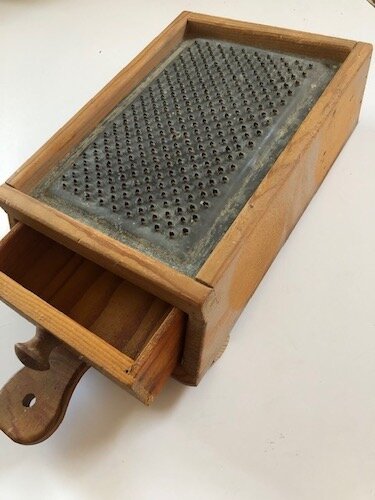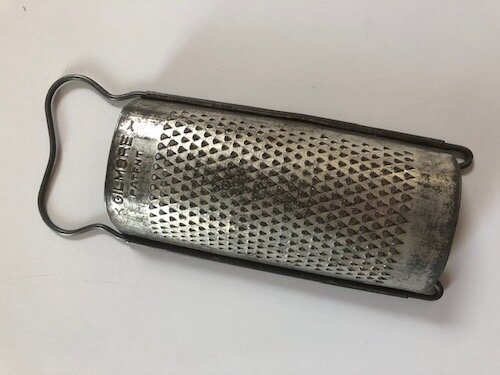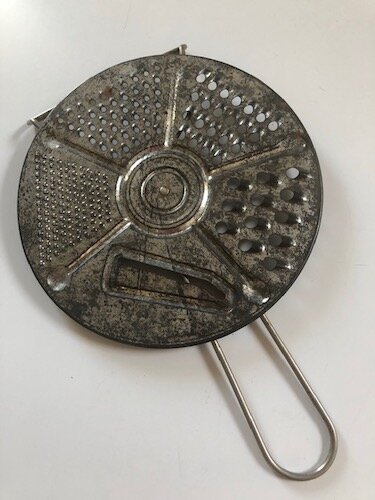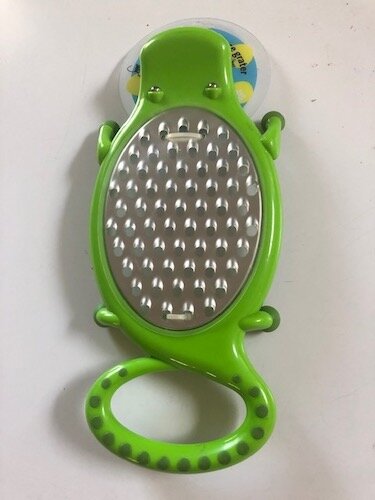Really Grate: The Kathleen Thompson Hill Collection of Cheese Graters
Editor’s note: Kathleen Thompson Hill is a food writer with an incredible collection of antique kitchen utensils. We asked her to share some photos of her cheese graters and tell us a bit about the history of this indispensable tool.
My quirky obsession with antique kitchen utensils started as my husband, Gerald Hill, and I began to travel less expensively as newlyweds. We hunted and haunted little remote antique shops in California’s Gold Country and along the Pacific Coast looking for something to give to my mother, Emily McKelligon Thompson, an artist, and interior designer. As we all know, we often give gifts to others that we like ourselves. So I kept selecting antique kitchen utensils hoping she would like them.
My mother’s box grater, ca. 1970s
The origins of a culinary collection
When my mother passed away, I took back those favorite utensils and began to explore what was going on in society when each piece was invented. It all started in my grandmother Bertha McKelligon’s kitchen, where I considered it a giddy privilege to sit in her breakfast nook and shell peas while she listened to her “programs” (soap operas) on the radio. Later as my culinary interests started to take over, I cut classes in French literature and politics at the Sorbonne in Paris and talked my way into being an “auditor” at the Cordon Bleu. My Kathleen Hill Culinary Collection now has grown to more than 3,000 pieces.
I have 122 categories of kitchen utensils, implements, gadgets, etc including cracker tins, egg beaters and whisks, food signs, toasters, mashers and pestles, meat grinders, food processors, sifters, slicers and dicers, spatulas and ladles, cough cutters, egg cookers, milk cans, ricers, dicers and food mills, pudding molds, chocolate molds, mayonnaise makers, food pamphlets, tea kettles, fruit crates, coffee grinders, tea strainers, and milk cans. I also have the whole wall of the history of food packaging auctioned off at the Copia bankruptcy sale.
Multi-surface folding cheese grater. Made in England, early 1900s
The collection also includes 70 to 80 cheese graters and other graters/choppers.
The collection on display
Handmade grater with hand-punched holes. Made in England, 1890s. Resembles the first American cheese grater made from a shower drain. Lining of some sort recommended.
Sonoma Valley Museum of Art hosted the first museum exhibition of my Kathleen Hill Culinary Collection. Then Executive Director and Chief Curator Kate Eilertson could see the art in each utensil and the combined art of my “Kitchen Memories” exhibit and its collective history.
Handmade cheese grater box with tin grater. Made in Frederick, Maryland, late 1800s. Drawer collects grated cheese (or grated anything) and pulls out.
During the opening night party, I stood in the museum’s entryway greeting people (450 of them), when Lilla Weinberger, co-owner of Readers’ Books, came out and told me, “Kathleen, you have to go in there and listen to people. Everyone is talking even if they don’t know each other.” I thought museums were supposed to be quiet.
It turns out that the most exciting outcome of displaying my collection at museums, retail stores, and restaurants is listening to everyone’s stories of which graters their mothers or grandfathers used to grate cheese over Sunday spaghetti and “gravy,” or “my mother had that one,” along with many first knuckle-grating experiences.
Gilmore half cylinder grater with handle looped to bottom rest extensions. Made in USA, 1800s.
The history of the cheese grater
François Boullier of France and Isaac Hunt of England both took credit for inventing the cheese grater in the 1540s. Ingredient supplies, mainly milk, ebbed and flowed in both France and England, as they have in the United States during this coronavirus pandemic.
Boullier originally aimed to use up an overabundance of cheese in Paris. An avoidance of meat led French farmers to convert their meat herds (often boys) to dairy-producers (girls), which led to more milk and even too much milk, which led to a market flooded with cheese. Boullier made his first cheese grater out of pewter to grate hard, sometimes dried out cheeses, which turned them into a sort of condiment. Pewter is known as a rather soft metal, and Boullier’s original grater is reportedly on display in a museum in Le Havre, France.
Isaac Hunt wanted to stretch cheese due to a shortage in England, so he grated and melted it for Welsh rarebit and other dishes. Grating cheese allowed more even distribution of the cheese to melt it in cooking and still does.
Artbeck Dial-a-matic grater and shredder. Made by Arthur Beck Co, Chicago, Illinois, USA, 1950s.
During the Great Depression of the 1930s, Philadelphia cheesemonger and entrepreneur Jeffrey Taylor also wanted to stretch cheese for to bulk up cheese features, including vegetables, to make them look like more filling food during difficult economic times. Taylor read about Boullier’s invention and made his own by sharpening the holes of a metal shower drain.
Bromwell’s Greater Grater “Knuckle Saver” cheese grater. Made in Cincinnati, Ohio, USA, 1930s.
For the last century, many companies have tried to improve the cheese grater and invent a new “latest” one that we all must-have. Graters are now made of all sorts of materials including bamboo, wood, and various metals. Some are decorated with clowns’ heads, some are shaped like plastic frogs, while others bear knuckle protectors. They vary in size, shape, and function. Grating slots come with different angles and shapes of slots and can grate everything from zucchini, onions and cheese, to cooked eggs, coconut, potatoes, cabbage, and lemon and orange peel, and possibly even create wood shavings. Smaller graters grate ginger and garlic.
Animal House Gator Cheese Grater “with ergonomic handle and non-slip feet.” Boston Warehouse Trading Corp, Norwood, MA, Made in China. 2009
One of my favorites is the Tala circular grater with square slots on the top for cheese or even for a French fry cutter top, made in England early 1900s. Sometimes older is better. I still reach for my mother’s box grater when I grate cheese, zucchini, or anything else.
Tala circular grater with cheese or French fry cutter top. Made in England early 1900s.

